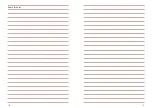
98
99
The accessory box
Content: Regulation pin, correction weights, crank, spare pendulum spring, tweezers, regulation
weights
Maintenance
The description above should have proved, that your new pendulum clock is a precision
chronometer of highest quality.
As every other instrument of this kind Cal. 1736 also requires careful handling and a certain
degree of maintenance. We therefore advise you never to keep the clock case open over
a long period of time, in order to prevent dust from depositing on the clockwork.
After 10 years the latest you should entrust your pendulum clock to a competent clockmaker's
workshop in order to have the clockwork cleaned and oiled anew. In the case of a pendulum
clock, which keeps precious time over many years , 24 hours a day, exactly to the second, this
should be self-evident. It will then untiringly do good service over decades and will be passed
on with pride from generation to generation as a precious chronometer.
Technical description
Opus Secunda M 130 – Precision pendulum clock Cal. 1736
•
Plates of 4mm thick, nickel-plated, rolled brass
•
Gear train in 11 precision ball bearings)
•
6 jewelled bearings in screwed chatons
•
2 agate pallets
•
Pinions of hardened steel
•
Gears finely crossed out, milled, precision-ground and gold-plated
•
Graham escapement
•
Gold-plated pallet body
•
Pendulum rod of heat treated super invar
•
Pendulum cylinder turned of solid brass, nickel-plated
•
Temperature compensation
•
Barometric-error compensation with twin barometer
•
Adjusting-table
•
Supports of solid stainless steel
•
Solid weight, 3100g on pulley with jewel bearings
•
Steel hands, hand-made polished and blued
•
Anodized dial aud printed
•
Moon phase - 3D moon ball
•
Lunette turned of solid brass, polished, nickel-plated
•
Winding period of 30 days
•
Accuracy: under optimal cond / - 3-4 seconds per month
•
Clock case of fine wood, carbon and fine metall inlay
•
Anti-reflexion crystals
•
Beat rate: 3600/h
The Moonphases
The moon circles the earth at a distance of 384.405 km and its diameter is 3.476 km.
The moon’s volume is 50 times less than that of the earths.
The gravitational pull is significantly less than that of the earth and all weights on the moon
are 6 times lighter. The temperature of the moon’s surface during the exposure to sunlight is
130° Celsius, while during the moonlight night which lasts two weeks is –158° Celsius.
It takes the moon 29 days, 12 hours, 44 minutes and 2.8 seconds to circle the globe.
The moon always shows the earth the same face. It rotates once around its owns axis during
this revolution.
2021
2022
2023
2024
2025
2026
January
!
13
!
2
1
7
!
11
1
13
1
3
1
28
1
18
!
21
1
25
!
29
!
18
February
!
11
!
1
1
5
!
9
1
12
1
1
1
27
1
16
!
20
1
24
!
28
!
17
March
!
13
!
2
1
7
!
10
1
14
1
3
1
28
1
18
!
21
1
25
!
29
!
19
April
!
12
!
1/30
1
6
!
8
1
13
1
2
1
27
1
16
!
20
1
24
!
27
!
17
May
!
11
1
16
1
5
!
8
1
12
1
1/31
1
26
!
30
!
19
1
23
!
27
!
16
June
!
10
1
14
1
4
!
6
1
11
!
15
1
24
!
29
!
18
1
22
!
25
1
29
July
!
10
1
13
1
3
!
6
1
10
!
14
1
24
!
28
!
17
1
21
!
24
1
29
August
!
8
1
12
1
1/31
!
4
1
9
!
12
1
22
!
27
!
16
1
19
!
23
1
28
September
!
7
1
10
1
15
!
3
1
7
!
11
1
21
!
25
!
29
1
18
!
21
1
26
October
!
6
1
9
1
14
!
2
1
7
!
10
1
20
!
25
!
28
1
17
!
21
1
26
November
!
4
1
8
1
13
!
1
1
5
!
9
1
19
!
23
!
27
1
15
!
20
1
24
December
!
4
1
8
1
13
!
1/30
1
5
!
9
1
19
!
23
!
27
1
15
!
20
1
24
1
=
full moon
!
=
new moon

























